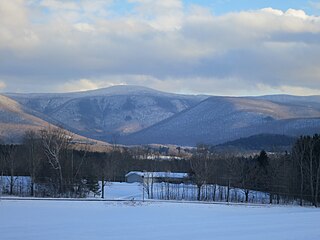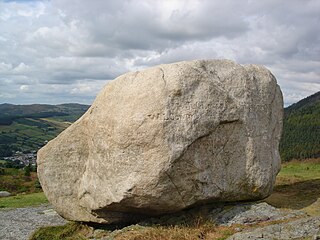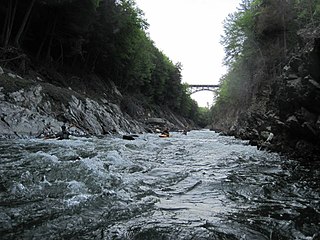
Mount Greylock is the highest point in Massachusetts at 3,489 feet. Located in northwest region of the state, it is part of the Taconic Mountains, a geologically distinct range from the nearby Berkshires and Green Mountains. Expansive views and a small area of sub-alpine forest characterize its upper reaches. A seasonal automobile road crosses the summit area near three structures from the 1930s, which together constitute a small National Historic District. Various hiking paths including the Appalachian Trail traverse the area, which is part of the larger Mount Greylock State Reservation.
The Northeast Kingdom is the northeast corner of the U.S. state of Vermont, approximately comprising Essex, Orleans, and Caledonia counties and with a population of 64,764 at the 2010 census. The term "Northeast Kingdom" is attributed to George D. Aiken, former Governor of Vermont and a U.S. senator, who first used the term in a 1949 speech.

Edward Hitchcock was an American geologist and the third President of Amherst College (1845–1854).

A glacial erratic is a glacially deposited rock differing from the type of rock native to the area in which it rests. Erratics, which take their name from the Latin word errare, are carried by glacial ice, often over distances of hundreds of kilometres. Erratics can range in size from pebbles to large boulders such as Big Rock in Alberta.

The Channeled Scablands are a relatively barren and soil-free region of interconnected relict and dry flood channels, coulees and cataracts eroded into Palouse loess and the typically flat-lying basalt flows that remain after cataclysmic floods within the southeastern part of Washington state. The Channeled Scablands were scoured by more than 40 cataclysmic floods during the Last Glacial Maximum and innumerable older cataclysmic floods over the last two million years. These floods were periodically unleashed whenever a large glacial lake broke through its ice dam and swept across eastern Washington and down the Columbia River Plateau during the Pleistocene epoch. The last of the cataclysmic floods occurred between 18,200 and 14,000 years ago.

Lake Hitchcock was a glacial lake that formed approximately 15,000 years ago in the late Pleistocene epoch. After the Laurentide Ice Sheet retreated, glacial ice melt accumulated at the terminal moraine and blocked up the Connecticut River, creating the long, narrow lake. The lake existed for approximately 3,000 years, after which a combination of erosion and continuing geological changes likely caused it to drain. At its longest, Lake Hitchcock stretched from the moraine dam at present-day Rocky Hill, Connecticut, to St. Johnsbury, Vermont. Although the rift valley through which the river flows above Rocky Hill actually continues south to New Haven, on Long Island Sound, the obstructing moraine at Rocky Hill diverted the river southeast to its present mouth at Old Saybrook.

Okotoks Erratic is a 16,500-tonne (18,200-ton) boulder that lies on the otherwise flat, relatively featureless, surface of the Canadian Prairies in Alberta. It is part of the 930-kilometre-long (580 mi) Foothills Erratics Train of typically angular boulders of distinctive quartzite and pebbly quartzite.

Cloughmore or Cloghmore, known locally as "The Big Stone", is a huge granite boulder perched on a mountainside almost 1,000 feet (300 m) above the village of Rostrevor, County Down, Northern Ireland. It sits on the slopes of Slieve Martin in Kilbroney Park, overlooking Rostrevor Forest, Carlingford Lough and the Cooley Peninsula. It is popular destination for visitors, and is part of a National Nature Reserve and Area of Special Scientific Interest.
The Rock River is a 12.9-mile-long (20.8 km) tributary of the West River in southern Vermont in the United States. Via the West River, it is part of the watershed of the Connecticut River.

During the American Civil War, the State of Vermont gave strong support to the Union war effort, raising troops and money. According to Rachel Cree Sherman:
By the spring of 1865 Vermont was devastated, having sent one tenth of its entire population to war, with a loss of over 5,000 lives to battle, wounds, and disease. The state had dedicated nearly $10 million to support the conflict, half of that amount offered up by towns with no expectation of recompense.

Haystack Mountain is located in Wilmington, Vermont, and is part of the Green Mountains mountain range. It has a summit of 3,445 feet and shares a ridgeline with neighboring Mt. Snow to the north. Haystack is “[a] mountain with a sharp summit cone and a broad, deep lake just under the precipitous peak. The view is a wide and complete panorama.” According to the 2015 Wilmington Municipal Plan, “Haystack Mountain and the ridgeline which forms the spine of the Green Mountain National Forest are prominent landforms. They provide a dramatic scenic impact from many viewpoints in Wilmington. Haystack Mountain boasts numerous hiking trails to the summit, capturing a broad vista of the valley below.” In his 1861 report, Edward Hitchcock described Haystack Mountain as, “one of the wildest, most rugged, and imposing peaks in Southern Vermont.”

The Hitchcock Ichnological Cabinet is a collection of fossil footmarks assembled between 1836 and 1865 by Edward Hitchcock (1793–1864), noted American geologist, state geologist of Massachusetts, United States, and President of Amherst College. He was one of the first experts in fossil tracks. A footmark impression in stone is a petrosomatoglyph.

The Foothills Erratics Train is a 580 miles (930 km) long, narrow, linear scatter of thousands of typically angular boulders of distinctive quartzite and pebbly quartzite that lie on the surface of a generally north-south strip of the Canadian Prairies. These boulders, which are between 1 foot (0.30 m) and 135 feet (41 m) in length, are glacial erratics that lie upon a surficial blanket of Late Wisconsin glacial till. The largest glacial erratic within the Foothills Erratics Train is Big Rock.
Lake Allison was a temporary lake in the Willamette Valley of Oregon, formed periodically by the Missoula Floods from 15,000 to 13,000 BC. The lake is the main cause of the rich and fertile soil that now characterizes the Willamette Valley.

Albert David Hager was an American geologist, librarian and historian.

Charles Henry Hitchcock was an American geologist.

New England is a region in the North Eastern United States consisting of the states Rhode Island, Connecticut, Massachusetts, New Hampshire, Vermont, and Maine. Most of New England consists geologically of volcanic island arcs that accreted onto the eastern edge of the Laurentian Craton in prehistoric times. Much of the bedrock found in New England is heavily metamorphosed due to the numerous mountain building events that occurred in the region. These events culminated in the formation of Pangaea; the coastline as it exists today was created by rifting during the Jurassic and Cretaceous periods. The most recent rock layers are glacial conglomerates.
Schimper Glacier is a glacier in the east part of Herbert Mountains, Shackleton Range, flowing north-northeast into Slessor Glacier.

Mount Hitchcock is a mountain located in South Hadley and Hadley, Massachusetts. It reaches 1,002 feet at its peak in South Hadley. The Metacomet-Monadnock Trail runs through it as it does for all the Holyoke Range. To the west is Seven Sisters and Mount Holyoke. To its east is Bare Mountain.

The Quechee Gorge is located in Quechee, Vermont along U.S. Route 4. The gorge is 165 feet deep and is the deepest gorge in Vermont. It serves as a popular tourist attraction in Quechee State Park and can be viewed from the U.S. Route 4 bridge and from trails on both sides of the gorge. Many people from around New England flock to the gorge for the views. The Ottauquechee River flows through the bottom of the gorge and is a popular whitewater kayak run.















